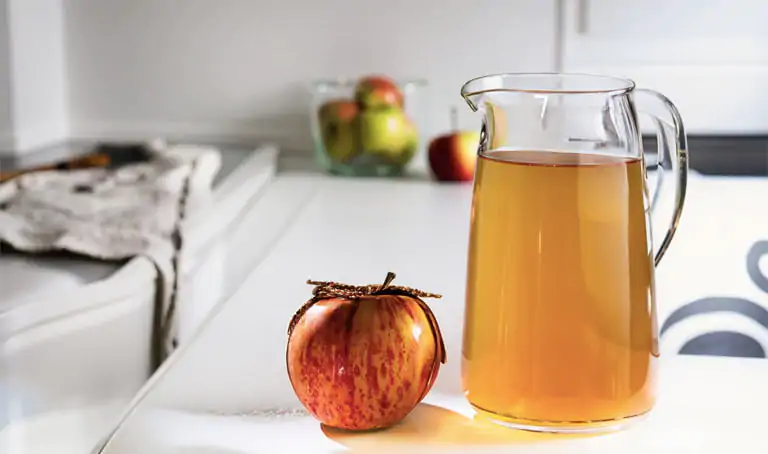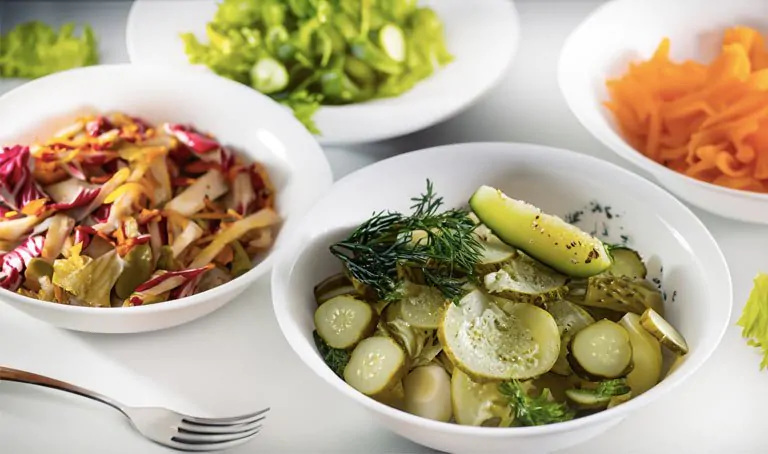Craving something tangy and wondering if your pickle jar could actually help you shed a few pounds? You’re not alone. Apple cider vinegar (ACV) and dill pickles have both been trending as “weight-loss hacks,” but do they really work, or is it just another health fad?
This detailed guide breaks down the facts, the science, and the safe ways to use both ACV and dill pickles as part of your healthy weight-loss plan.
Apple cider vinegar and dill pickles are two of the most talked-about tangy foods in the wellness world. People claim they curb appetite, burn fat, and help regulate blood sugar, but how much of that is true?
Here’s what we know: ACV contains acetic acid, a compound that has been studied for its role in appetite control and metabolism. Dill pickles, on the other hand, are low in calories and can satisfy cravings for something salty and crunchy. Combined, they might form a simple strategy for mindful eating, but they aren’t magic bullets.
Let’s break it all down step by step.

Understanding the Basics
What is Apple Cider Vinegar (ACV)?
Apple cider vinegar is made by fermenting crushed apples with yeast and bacteria. This process produces acetic acid, which gives ACV its strong smell and sour taste.
Key components include:
- Acetic acid (main active compound)
- Trace minerals (potassium, magnesium)
- Probiotics (in unfiltered “with the mother” varieties)
Why it’s talked about for weight loss: Studies suggest acetic acid may help slow digestion, reduce blood sugar spikes, and increase feelings of fullness, potentially leading to reduced calorie intake throughout the day.
What are Dill Pickles?
Dill pickles are cucumbers preserved in a brine of vinegar, water, salt, and dill herbs. Depending on the preparation method, they can be fermented (naturally rich in probiotics) or vinegar-based (acidified for preservation).
Typical nutrition per spear (28 g):
| Nutrient | Amount |
| Calories | 4–6 kcal |
| Sodium | 250–300 mg |
| Fat | 0 g |
| Carbohydrates | <1 g |
| Protein | 0 g |
Quick fact: Dill pickles made with apple cider vinegar combine both benefits, acetic acid from vinegar and the low-calorie crunch of pickles.
How ACV & Dill Pickles May Support Weight Loss
Evidence for ACV in Weight Management
Several small-scale studies have explored ACV’s effects on body weight and appetite:
- Appetite Control: Acetic acid may promote a feeling of fullness by slowing down stomach emptying. People who consume diluted ACV before meals sometimes eat less overall.
- Metabolic Support: Some research indicates that vinegar can improve insulin sensitivity, which may reduce fat storage and sugar cravings.
- Clinical Results: In one 12-week study, participants who took 1–2 tablespoons (15–30 mL) of ACV daily lost a few pounds more than those who didn’t. The difference was modest but statistically significant.
Important note: These effects are mild and work best when ACV is paired with a balanced diet and regular physical activity.
Evidence for Dill Pickles in Weight Loss
While dill pickles haven’t been studied as extensively as ACV, their nutritional profile makes them a smart choice for dieters.
Here’s why:
- Low-Calorie Crunch: One or two pickle spears can satisfy a salty craving for under 10 calories.
- Vinegar Content: Vinegar in pickles may help regulate blood sugar and appetite in the same way as ACV.
- Probiotic Support (Fermented Types): Natural pickles made through fermentation can boost gut health, which is linked to better metabolism and digestion.
However: High-sodium pickles can lead to water retention or bloating. It’s best to consume them in moderation and choose low-sodium versions.
Why Combining ACV and Dill Pickles Makes Sense
When you pair ACV with dill pickles, you’re essentially doubling down on the acetic acid benefit while keeping your snack calories minimal.
- Pickles made with apple cider vinegar can enhance satiety and flavor.
- Eating something tangy and crunchy before or with meals may prevent overeating.
- This combination can make healthy eating feel satisfying instead of restrictive.
Think of them as a natural appetite-control duo, a way to keep flavor alive while managing portions.

Real-World Practical Guide
Choosing the Right Pickles
When shopping for pickles, not all jars are created equal. Follow these quick tips:
- Check for sodium: Aim for under 250 mg per spear if possible.
- Skip added sugar: Avoid “bread-and-butter” or sweet pickles.
- Look for “fermented” or “raw” pickles: These contain probiotics that support gut health.
- Inspect ingredients: Fewer additives and preservatives are better.
Homemade pickles with apple cider vinegar are an excellent option if you want full control over ingredients.
Using Apple Cider Vinegar Safely
ACV is highly acidic, so using it the right way is crucial.
Safe Dosage: 1–2 tablespoons (15–30 mL) daily is the most common dose in research.
How to Take It:
- Dilute it: Mix with at least 1 cup (250 mL) of water.
- Before meals: Taking it 15–30 minutes before eating may help reduce appetite.
- As a dressing: Combine ACV with olive oil and herbs for a flavorful salad dressing.
Avoid:
- Drinking it straight (can erode tooth enamel and irritate the throat)
- Taking too much (can cause stomach upset or interact with medications)
Adding ACV-Based Dill Pickles to Your Diet

Here are practical ways to enjoy them daily:
- Snack replacement: Instead of chips, grab two dill pickle spears with a handful of nuts or low-fat cheese.
- Meal flavor boost: Add chopped pickles to salads, wraps, or tuna for extra tang without extra calories.
- Craving control: A pickle spear before a meal can help you start eating mindfully.
- DIY pickle boost: Make your own ACV pickles by soaking sliced cucumbers in apple cider vinegar, water, salt, dill, and garlic for 24–48 hours.
Sample Snack and Meal Plan

Morning:
- Warm water with 1 teaspoon ACV (diluted) before breakfast
- Oatmeal with fruit and a boiled egg
Lunch:
- Grilled chicken salad with olive oil + ACV dressing
- Add chopped dill pickles for crunch and flavor
Snack:
- A few pickle spears + 10 almonds
Dinner:
- Stir-fried vegetables and lean protein
- 1 tablespoon diluted ACV before meal

Tip: Keep your total sodium intake in check by balancing pickles with potassium-rich foods like bananas and spinach.
What the Science Doesn’t Fully Show & Risks
While the early evidence is promising, there are still gaps in research.
Limitations
- Most ACV studies involve small groups over short periods.
- Results can vary depending on diet, lifestyle, and body type.
- For pickles, some research even links frequent consumption to higher sodium intake and water weight gain.
Potential Risks
- ACV overuse: Can harm tooth enamel and irritate the throat.
- Pickles: Excess sodium may raise blood pressure or cause bloating.
- Digestive sensitivity: Some people may experience nausea or acid reflux.
- Medication interactions: ACV may affect blood sugar or potassium levels, so consult a healthcare professional if on medication.
Bottom line: Moderation is key. Using ACV and pickles as flavor boosters, not miracle cures, keeps them safe and effective.
Myths & Misconceptions
Myth 1: “ACV melts belly fat.”
No vinegar “melts” fat. It may reduce appetite slightly, but fat loss still requires a calorie deficit.
Myth 2: “All pickles are healthy.”
Sweet or heavily processed pickles are loaded with sugar and sodium, definitely not diet-friendly.
Myth 3: “Fermented and vinegar pickles are the same.”
They’re not. Fermented pickles use natural bacteria and are probiotic-rich, while vinegar pickles rely on acid for preservation.
Verdict: Should You Use Them?
Here’s the honest answer: Yes, apple cider vinegar and dill pickles can support weight-loss efforts, but only as part of a balanced routine.
They can help you:
- Feel fuller before meals
- Snack smarter with fewer calories
- Add flavor without adding fat
But they won’t replace exercise, sleep, and a balanced diet. Think of them as supportive tools, not solutions.
Smart approach:
- Choose low-sodium, vinegar-based or fermented pickles.
- Use diluted ACV safely before meals.
- Focus on long-term habits, not quick fixes.
Action Plan & Takeaway Tips
Quick Checklist
- ✅ Use 1–2 tablespoons of ACV per day (always diluted)
- ✅ Choose low-sodium, unsweetened dill pickles
- ✅ Pair pickles or ACV with protein and fiber
- ✅ Avoid overconsumption to prevent bloating or acid reflux
- ✅ Drink plenty of water throughout the day
30-Day Mini-Challenge
| Week | Goal | Focus |
| Week 1 | Add 1 tsp diluted ACV before dinner | Notice appetite & digestion |
| Week 2 | Replace chips with dill pickles for one snack | Reduce empty calories |
| Week 3 | Make your own ACV dill pickles | Control sodium & flavor |
| Week 4 | Track your cravings and energy | Adjust based on how you feel |
When to Stop or Adjust: If you notice bloating, heartburn, or excessive thirst, reduce intake or switch to lower-sodium options.
Frequently Asked Questions
How many calories are in dill pickles?
Most dill pickles have under 10 calories per spear, making them a guilt-free snack.
How much apple cider vinegar should I take daily?
1–2 tablespoons (15–30 mL), diluted in water, is sufficient for most people.
Can I drink pickle juice?
Yes, but in moderation. It’s rich in electrolytes but also high in sodium.
Are fermented pickles better than vinegar pickles?
Fermented pickles offer probiotics for gut health, while vinegar pickles rely on acetic acid. Both can be healthy when consumed wisely.
Is this safe if I have high blood pressure?
If you have hypertension, choose low-sodium pickles and limit portions. Always consult your doctor before making dietary changes.
Conclusion
Apple cider vinegar and dill pickles can play a supportive role in weight management when used smartly. They’re low in calories, rich in flavor, and may help control appetite, but they’re not miracle foods.
Combine them with balanced meals, plenty of water, daily activity, and mindful eating for real, lasting results. A tangy crunch and a splash of vinegar might just make healthy eating a little more enjoyable, and sustainable.


